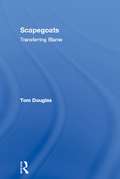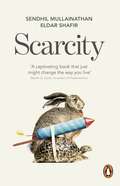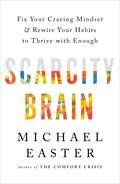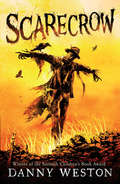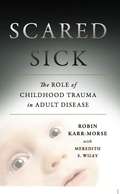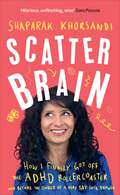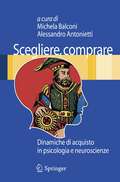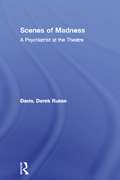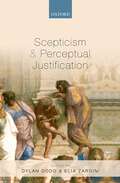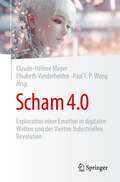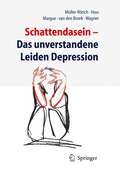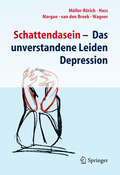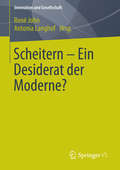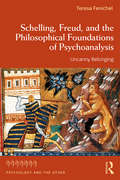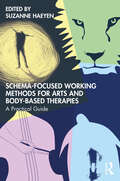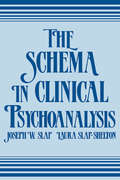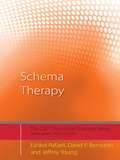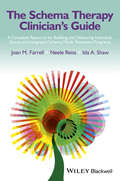- Table View
- List View
Scapegoats: Transferring Blame
by Tom DouglasScapegoats are a universal phenomenon, appearing in all societies at all times in groups large and small, in public and private organizations. Hardly a week passes without some media reference to someone or something being made a scapegoat. Tom Douglas examines the process of scapegoating from the perspectives of victims and perpetrators, tracing its development from earliest times as rite of atonement to the modern forms of the avoidance of blame and the victimisation of innocents. The differences and similarities between the ancient and modern forms are examined to reveal that despite the modern logical explanations of behaviour, the mystical element in the form of superstition is still evident. Directly responding to the Diploma in Social Work's call for texts on anti-discriminatory practice Scapegoats should become essential reading for all social workers in training and practice. Will also be a invaluable resource for all professionals engaging in groupwork and group workers in training.
Scapegoats: Transferring Blame
by Tom DouglasScapegoats are a universal phenomenon, appearing in all societies at all times in groups large and small, in public and private organizations. Hardly a week passes without some media reference to someone or something being made a scapegoat. Tom Douglas examines the process of scapegoating from the perspectives of victims and perpetrators, tracing its development from earliest times as rite of atonement to the modern forms of the avoidance of blame and the victimisation of innocents. The differences and similarities between the ancient and modern forms are examined to reveal that despite the modern logical explanations of behaviour, the mystical element in the form of superstition is still evident. Directly responding to the Diploma in Social Work's call for texts on anti-discriminatory practice Scapegoats should become essential reading for all social workers in training and practice. Will also be a invaluable resource for all professionals engaging in groupwork and group workers in training.
Scarcity: Why having too little means so much
by Sendhil Mullainathan Eldar ShafirWhy can we never seem to keep on top of our workload, social diary or chores? Why does poverty persist around the world? Why do successful people do things at the last minute in a sudden rush of energy? Here, economist Sendhil Mullainathan and psychologist Eldar Shafir reveal that the hidden side of all these problems is that they're all about scarcity. We've all struggled with packing a suitcase with too many items and not enough time to do it. In Scarcity, two intellectual adventurers show us that this simple idea explains the most fundamental problems in all walks of life. Using the new science of scarcity, they explain why obesity is rampant; why people find it difficult to sleep when most sleep deprived; and why the lonely find it so hard to make friends. Scarcity will change the way you think about both the little everyday tasks and the big issues of global urgency.Sendhil Mullainathan is a Professor of Economics at Harvard, and a recipient of a MacArthur Foundation "genius grant". He conducts research on development economics, behavioral economics, and corporate finance. He is Executive Director of Ideas 42, Institute of Quantitative Social Science, Harvard University.Eldar Shafir is William Stewart Tod Professor of Psychology and Public Affairs at Princeton University. Most of his work focuses on descriptive analyses of inference, judgment, and decision making, and on issues related to behavioral economics.'Stars in their respective disciplines, and the combination is greater than the sum of its parts. Their project has a unique feel to it: it is the finest combination of heart and head that I have seen in our field', Daniel Kahneman, author of Thinking, Fast and Slow'Scarcity is a captivating book, overflowing with new ideas, fantastic stories, and simple suggestions that just might change the way you live'Steven D. Levitt, coauthor of Freakonomics'Here is a winning recipe. Take a behavioral economist and a cognitive psychologist, each a prominent leader in his field, and let their creative minds commingle. What you get is a highly original and easily readable book that is full of intriguing insights. What does a single mom trying to make partner at a major law firm have in common with a peasant who spends half her income on interest payments? The answer is scarcity. Read this book to learn the surprising ways in which scarcity affects us all', Richard Thaler, co-author of Nudge
Scarcity Brain: Fix Your Craving Mindset and Rewire Your Habits to Thrive with Enough
by Michael EasterAre we hardwired to crave more? From food and stuff to information and influence, why can't we ever get enough?Michael Easter, author of The Comfort Crisis and one of the world's leading experts on behavior change, shows that the problem isn't you. The problem is your scarcity mindset, left over from our ancient ancestors. They had to constantly seek and consume to survive because vital survival tools like food, material goods, information, and power were scarce and hard to find. But with our modern ability to easily fulfill our ancient desire for more, our hardwired "scarcity brain" is now backfiring. And new technology and institutions - from dating and entertainment apps to our food and economic systems - are exploiting our scarcity brain. They're bombarding us with subversive "scarcity cues," subtle triggers that lead us into low-reward cravings that hurt us in the long run. Scarcity cues can be direct and all-encompassing, like a sagging economy. Or they can be subtle and slight, like our neighbour buying a shiny new car. Easter traveled the world to consult with remarkable innovators and leading scientists who are finding surprising solutions for our scarcity brain. He discovered simple tactics that can move us towards an abundance mindset, cement healthy habits, and allow us to live our lives to the fullest and appreciate what we have, including how to: - Detect hidden scarcity cues to stop cravings before they start, from a brilliant slot machine designer in a Las Vegas casino laboratory- Turn alone time into the ultimate happiness hack, from artisanal coffee-making Benedictine monks Reignite your exploration gene for a more exciting and fulfilling life, from an astronaut onboard the International Space Station- Reframe how we think about and fix addiction and bad habits, from Iraq's chief psychiatrist- Recognize when you have enough, from a woman who left a million-dollar career path to adventure the worldOur world is overloaded with everything we're built to crave. The fix for scarcity brain isn't to blindly aim for less. It's to understand why we crave more in the first place, shake our worst habits, and use what we already have better. Then we can experience life in a new way - a more satisfying way.
Scarecrow
by Danny WestonJack and his dad are runaways. Jack’s father recently turned whistleblower, revealing the truth about the illicit dealings of some powerful people. Realising that he and Jack might be in danger, Dad drives them to a remote shooting lodge in the Scottish Highlands, where they intend to lay low. In the cornfield beside the lodge stands a scarecrow. When Jack witnesses something incredible, he begins to realise that it is no ordinary scarecrow – it is alive, hungry and fuelled by rage. And when Dad’s enemies begin to converge on the lodge, the scarecrow might just turn out to be Jack’s best hope of survival.
Scared Sick: The Role of Childhood Trauma in Adult Disease
by Robin Karr-MorseThe first years of human life are more important than we ever realized. In Scared Sick, Robin Karr-Morse connects psychology, neurobiology, endocrinology, immunology, and genetics to demonstrate how chronic fear in infancy and early childhood- when we are most helpless-lies at the root of common diseases in adulthood. Compassionate and based on the latest research, Scared Sick will unveil a major public health crisis. Highlighting case studies and cutting-edge scientific findings, Karr- Morse shows how our innate fight-or-flight system can injure us if overworked in the early stages of life. Persistent stress can trigger diabetes, heart disease, obesity, depression, and addiction later on.
Scatter Brain: How I finally got off the ADHD rollercoaster and became the owner of a very tidy sock drawer
by Shaparak Khorsandi'Hilarious, unflinching, wise' - Sara Pascoe'Intensely personal, highly educational and very funny' - Adam Kay'Some brains, through no fault of their own, pack a bag, turn the lights off and run away to the seaside the moment they are meant to be doing homework, paying bills or not putting the cat in the fridge. These are ADHD brains. I have one and believe they are as common as being left-handed, flat footed or genuinely enjoying anchovies on a pizza. Undiagnosed Attention Deficit Hyperactivity Disorder made my life a frustrating, maddening rollercoaster. I had very little focus except when I was hyper-focusing (and then it would always be on the wrong things), I made the same mistakes over and over again, regularly burning myself out until I was sobbing. When I finally was diagnosed in my 40s it felt like the lights had been turned on after a lifetime in the dark.'Join much-loved comedian Shaparak Khorsandi as she looks back on her life through the lens of ADHD and finally makes sense of the chaos. From discovering the joys of shoplifting through to finally understanding her attraction to toxic men, Scatter Brain will have you laughing (and crying) as you find out what it's really like to live a life out of control. Whether you suspect you might have ADHD or you're just here for the ride, let Shaparak take you on her heartbreaking and hilarious journey of self-discovery where you just might learn something useful about yourself too!
Scegliere, comprare: Dinamiche di acquisto in psicologia e neuroscienze
by Michela Balconi Alessandro AntoniettiAnche il marketing, come tanti ambiti professionali, vive oggi l’opportunità di aggiornare i paradigmi e le metodologie tradizionali grazie a contributi provenienti da altre discipline, soprattutto da quelle di più recente sviluppo. Tra queste, si segnalano oggi la psicologia cognitiva e le neuroscienze. Il libro intende offrire al lettore uno spaccato di quanto questi due settori possono offrire alla comprensione delle dinamiche di acquisto, mostrando come la conoscenza dei meccanismi di pensiero e dei processi cerebrali aiuti a identificare ciò che accade nella mente del destinatario della comunicazione pubblicitaria e di colui che si trova a dover valutare e scegliere se e che cosa comprare. Psicologia e neuroscienze mettono oggi a disposizione di chi studia i comportamenti di acquisto sia nuovi modelli concettuali, sia nuovi strumenti e procedure di analisi. I contributi raccolti nel volume offrono al lettore da un lato delle rassegne circa i più recenti contributi di queste discipline al marketing, dall’altro esempi di ricerche da cui è possibile ricavare spunti applicativi. Nel complesso risulta un quadro generale di alcune delle più promettenti tendenze e linee di indagine che si stanno affermando nel settore.
Scenes of Madness: A Psychiatrist at the Theatre
by Derek Russell DavisDerek Russell Davis argues that mental health professionals working in a hospital or clinic setting can learn much from playwrights about the psychological processes in mental illness. Looking at such diverse characters as Orestes, Hamlet, Lear, Ophelia, Peer Gynt, Oswald Alving and Blanche Dubois, Dr Davis shows how madness in plays is put into the context of the crucial experiences in an individual's history and current relationships, and demonstrates that these stories can be a new and exciting source of insight into mental illness.
Scenes of Madness: A Psychiatrist at the Theatre
by Derek Russell DavisDerek Russell Davis argues that mental health professionals working in a hospital or clinic setting can learn much from playwrights about the psychological processes in mental illness. Looking at such diverse characters as Orestes, Hamlet, Lear, Ophelia, Peer Gynt, Oswald Alving and Blanche Dubois, Dr Davis shows how madness in plays is put into the context of the crucial experiences in an individual's history and current relationships, and demonstrates that these stories can be a new and exciting source of insight into mental illness.
Scepticism And Perceptual Justification
by Dylan Dodd Elia ZardiniOne of the hardest problems in the history of Western philosophy has been to explain whether and how experience can provide knowledge (or even justification for belief) about the objective world outside the experiencer's mind. A prominent brand of scepticism has precisely denied that experience can provide such knowledge. How, for instance (these sceptics ask) can I know that my experiences are not produced in me by a powerful demon (or, in a modern twist on that traditional Cartesian scenario, by a supercomputer)? This volume, originating from the research project on Basic Knowledge recently concluded at the Northern Institute of Philosophy, presents new essays on scepticism about the senses written by some of the most prominent contemporary epistemologists. They approach the sceptical challenge by discussing such topics as the conditions for perceptual justification, the existence of a non-evidential kind of warrant and the extent of one's evidence, the epistemology of inference, the relations between justification, probability and certainty, the relevance of subjective appearances to the epistemology of perception, the role that broadly pragmatic considerations play in epistemic justification, the contents of perception, and the function of attention. In all these cases, the papers show how philosophical progress on foundational issues can improve our understanding of and possibly afford a solution to a historically prominent problem like scepticism.
Schacter's cognitive labelling theory (Large Print)
by Rnib BookshareThis image is a flow chart which reads from left to right and bottom to top with four boxes and six arrows. There is a locator dot shown, which will be at the top left of the page when the image is the right way up. This image shows a box on the left representing the stimulus with two arrows on the right, one pointing diagonally up to a box cognitive appraisal of arousal, and the other down to a box physiological changes. This box has a labelled arrow extending vertically upwards via the thalamus sending impulses to the cortex to the top box. The boxes cognitive appraisal of arousal and physiological changes have arrows pointing to a fourth box on the right subjective experience of emotion.
Scham 4.0: Exploration einer Emotion in digitalen Welten und der Vierten Industriellen Revolution
by Elisabeth Vanderheiden Claude-Hélène Mayer Paul T. P. WongDieser Sammelband bietet neue Perspektiven darauf, wie das Gefühl Scham in digitalen Welten und in der Industrie 4.0 erlebt und verändert wird. Die Herausgeber*innen und Autor*innen diskutieren, wie Individuen und Organisationen Scham am Arbeitsplatz, in beruflichen und privaten Kontexten und im Hinblick auf soziokulturelle Lebensstilveränderungen konstruktiv transformieren können. Die Beiträge in diesem Band ermöglichen es Forscher*innen und Praktiker*innen gleichermaßen, das Thema Scham und seine Spezifika in einer hochdynamischen und sich schnell verändernden Zeit zu erschließen. Das Verständnis für diese Emotion im Zusammenhang mit Home Office, automatisierten Realitäten und smarten Systemen oder digitalisierten Lebens- und Arbeitsstilen wird vertieft. Durch den Einsatz transdisziplinärer und transkultureller Perspektiven erörtert der Band darüber hinaus Scham im Kontext neuer Lebensstile, Religion, Geschlecht, sexueller Unterdrückung und psychischer Erkrankungen. Forscher*innen, Praktiker*innen und Studierende aus den Bereichen Arbeits- und Organisationspsychologie, Positive Psychologie, Organisationsforschung, Zukunftsforschung, Gesundheits- und Arbeitswissenschaft, Therapie und Beratung, Emotionswissenschaften, Management, Führung und Personalwesen werden die Beiträge als hochaktuell, aufschlussreich und praxisrelevant empfinden.
Schattendasein: Das unverstandene Leiden Depression
by T. Müller-Rörich K. Hass F. Margue Annekäthi van den Broek R. WagnerSchattendasein: Anders als bei anderen Krankheiten wagen es depressive Menschen häufig nicht, über ihre Erkrankung zu sprechen. Unterstützung und Austausch finden sie seit einigen Jahren im Internetforum des "Kompetenznetz Depression, Suizidalität". Vier Betroffene und eine Angehörige sichteten nun die Postings des Forums, kommentierten sie und verdichteten sie zu einem Ratgeber – fachlich betreut von Ärzten des Kompetenznetzes Depression. Sie führen zahlreiche Informationen auf: von der Frage wie sich Depression äußert über mögliche Therapien, die Rolle des sozialen Umfeldes bis hin zur Gesundung. Ein vielstimmiges und zugleich fundiertes Bild.
Schattendasein: Das unverstandene Leiden Depression
by Thomas Müller-Rörich Kirsten Hass Françoise Margue Annekäthi van den Broek Rita WagnerMenschen mit Depression können oft über ihre Erkrankung nicht sprechen, nutzen aber das Internetforum des Kompetenznetzes Depression, Suizidalität. Vier Betroffene und eine Angehörige haben für diesen Ratgeber die Einträge gesichtet und kommentiert – fachlich betreut von Ärzten des Kompetenznetzes. Erläutert werden die wichtigsten Fragen, die sich Betroffene stellen: Wie äußert sich eine Depression? Welche Therapien gibt es? Welche Rolle spielt das soziale Umfeld? Für Betroffene, aber auch für Fachleute, die die „Innenansicht“ interessiert.
Scheitern - Ein Desiderat der Moderne? (Innovation und Gesellschaft)
by René John Antonia LanghofDas Phänomen „Scheiterns“ findet man auf der Schattenseite der Gesellschaft. Ist es dann schon verständlich, dass dessen begriffliche Bestimmung und empirische Beschreibung durch die Sozialwissenschaften nur unzureichend ausfällt? Bis auf die organisationstheoretischen Bemühungen macht die Diskussion einen eher ungenügenden Eindruck. Dabei bildet Scheitern unvermeidlich die negative Folie für den Nachweis erfolgreicher Lösungen. Von daher weist Scheitern eine heimliche Prominenz auf, der sich die Sozialwissenschaften stellen müssen. Mit dem Buch wird die bisherige Diskussion dazu aufgenommen, fortgeführt und angereichert. Auf diese Weise wird ein weiterer Grundstein für die Etablierung der Perspektive des Scheiterns in den Sozialwissenschaften gelegt, mit dem nicht nur dieses höchst relevante Problem in den wissenschaftlichen Fokus gerückt wird, sondern überhaupt erst brauchbare Erkenntnisse über die Bedingungen der Möglichkeit des Erfolges zu gewinnen sind.
Schelling, Freud, and the Philosophical Foundations of Psychoanalysis: Uncanny Belonging (Psychology and the Other)
by Teresa FenichelSchelling, Freud, and the Philosophical Foundations of Psychoanalysis provides a long-overdue dialogue between two seminal thinkers, Schelling and Freud. Through a sustained reading of the sublime, mythology, the uncanny, and freedom, this book provokes the reader to retrieve and revive the shared roots of philosophy and psychoanalysis. Teresa Fenichel examines the philosophical basis for the concepts of the unconscious and for the nature of human freedom on which psychoanalysis rests. Drawing on the work of German philosopher F. W. J. Schelling, the author explores how his philosophical understanding of human actions, based as it was on the ideas of drives, informed and helped shape Freud’s work. Fenichel also stresses the philosophical weight of Freudian psychoanalysis, specifically in regards to the problem of freedom and argues that psychoanalysis complicates and reinforces Schelling’s basic idea: to know reality we must engage with the world empathetically and intimately. This book also serves as an introduction to Schelling’s thought, arguing that his metaphysics—particularly concerning the primacy of the unconscious and of fantasy—can be read as a therapeutic endeavor. Finally, the book offers a deep rethinking of the action and nature of sublimation through both Freud’s and Schelling’s texts. Fenichel suggests psychoanalytic therapy is self-interpretation—a recognition of our narratives as narratives, without for that reason taking them any less seriously. Schelling, Freud, and the Philosophical Foundations of Psychoanalysis will be of great interest to psychoanalysts and psychoanalytic psychotherapists as well as scholars of philosophy.
Schelling, Freud, and the Philosophical Foundations of Psychoanalysis: Uncanny Belonging (Psychology and the Other)
by Teresa FenichelSchelling, Freud, and the Philosophical Foundations of Psychoanalysis provides a long-overdue dialogue between two seminal thinkers, Schelling and Freud. Through a sustained reading of the sublime, mythology, the uncanny, and freedom, this book provokes the reader to retrieve and revive the shared roots of philosophy and psychoanalysis. Teresa Fenichel examines the philosophical basis for the concepts of the unconscious and for the nature of human freedom on which psychoanalysis rests. Drawing on the work of German philosopher F. W. J. Schelling, the author explores how his philosophical understanding of human actions, based as it was on the ideas of drives, informed and helped shape Freud’s work. Fenichel also stresses the philosophical weight of Freudian psychoanalysis, specifically in regards to the problem of freedom and argues that psychoanalysis complicates and reinforces Schelling’s basic idea: to know reality we must engage with the world empathetically and intimately. This book also serves as an introduction to Schelling’s thought, arguing that his metaphysics—particularly concerning the primacy of the unconscious and of fantasy—can be read as a therapeutic endeavor. Finally, the book offers a deep rethinking of the action and nature of sublimation through both Freud’s and Schelling’s texts. Fenichel suggests psychoanalytic therapy is self-interpretation—a recognition of our narratives as narratives, without for that reason taking them any less seriously. Schelling, Freud, and the Philosophical Foundations of Psychoanalysis will be of great interest to psychoanalysts and psychoanalytic psychotherapists as well as scholars of philosophy.
Schema-Focused Working Methods for Arts and Body-Based Therapies
by Suzanne HaeyenThis book introduces schema-focused working methods for arts and body-based therapies, offering therapists practice-based tools to help their clients strengthen healthy patterns, self-management, and well-being on their path to recovery.Containing 158 schema-focused working methods for different arts and body-based therapies, such as art therapy, dance therapy, drama therapy, music therapy, and body-based or psychomotor therapy, this book offers new ideas and tools for therapists to strengthen their client’s adaptive schema modes: the Healthy Adult and the Happy Child. By linking arts and body-based therapies to schema-focused therapy and positive psychology, the goal is to strengthen the client’s healthy patterns in emotion regulation and establish a healthier well-being.The theoretical framework in the introduction and the scientific evidence for arts and psychomotor therapies, combined with the practice-based examples, allow for a text that is broad enough for graduate creative therapy programs and specific enough to serve as a shelf reference for those in practice.
Schema-Focused Working Methods for Arts and Body-Based Therapies
This book introduces schema-focused working methods for arts and body-based therapies, offering therapists practice-based tools to help their clients strengthen healthy patterns, self-management, and well-being on their path to recovery.Containing 158 schema-focused working methods for different arts and body-based therapies, such as art therapy, dance therapy, drama therapy, music therapy, and body-based or psychomotor therapy, this book offers new ideas and tools for therapists to strengthen their client’s adaptive schema modes: the Healthy Adult and the Happy Child. By linking arts and body-based therapies to schema-focused therapy and positive psychology, the goal is to strengthen the client’s healthy patterns in emotion regulation and establish a healthier well-being.The theoretical framework in the introduction and the scientific evidence for arts and psychomotor therapies, combined with the practice-based examples, allow for a text that is broad enough for graduate creative therapy programs and specific enough to serve as a shelf reference for those in practice.
The Schema in Clinical Psychoanalysis
by Joseph W. Slap Laura Slap-SheltonSlap and Slap-Shelton proffer the schema as the basis of an internally consistent and clinically relevant model of the mind. Wedded to the dynamic and genetic points of view, the schema model accommodates the clinical realities of trauma, repetition, and sublimation while dispensing entirely with the abstract concepts of traditional metapsychology.
The Schema in Clinical Psychoanalysis
by Joseph W. Slap Laura Slap-SheltonSlap and Slap-Shelton proffer the schema as the basis of an internally consistent and clinically relevant model of the mind. Wedded to the dynamic and genetic points of view, the schema model accommodates the clinical realities of trauma, repetition, and sublimation while dispensing entirely with the abstract concepts of traditional metapsychology.
Schema Therapy: Distinctive Features (CBT Distinctive Features)
by Eshkol Rafaeli David P. Bernstein Jeffrey YoungSchema Therapy combines proven cognitive behavioral therapy techniques with elements of interpersonal, experiential, and psychodynamic therapies in order to help people with long-term mental health problems including personality disorders and chronic depression. Schema Therapy suggests that many negative cognitive conditions are based on past experiences, and therefore provides models for challenging and modifying negative thoughts and behaviors in order to provoke change. In this book, Eshkol Rafaeli, David P. Bernstein and Jeffrey Young – pioneers of the Schema Therapy approach – indicate the 30 distinctive features of Schema Therapy, and how the method fits into the broader CBT spectrum. Divided into two parts, Theoretical Points and Practical Points, this book provides a concise introduction for those new to the technique, as well as a discussion of how it differs from the other cognitive behavioral therapies for those experienced in the field.
Schema Therapy: Distinctive Features (CBT Distinctive Features)
by Eshkol Rafaeli David P. Bernstein Jeffrey YoungSchema Therapy combines proven cognitive behavioral therapy techniques with elements of interpersonal, experiential, and psychodynamic therapies in order to help people with long-term mental health problems including personality disorders and chronic depression. Schema Therapy suggests that many negative cognitive conditions are based on past experiences, and therefore provides models for challenging and modifying negative thoughts and behaviors in order to provoke change. In this book, Eshkol Rafaeli, David P. Bernstein and Jeffrey Young – pioneers of the Schema Therapy approach – indicate the 30 distinctive features of Schema Therapy, and how the method fits into the broader CBT spectrum. Divided into two parts, Theoretical Points and Practical Points, this book provides a concise introduction for those new to the technique, as well as a discussion of how it differs from the other cognitive behavioral therapies for those experienced in the field.
The Schema Therapy Clinician's Guide: A Complete Resource for Building and Delivering Individual, Group and Integrated Schema Mode Treatment Programs
by Joan M. Farrell Neele Reiss Ida A. ShawThe Schema Therapy Clinician’s Guide is a complete clinical resource for psychotherapists implementing schema therapy, group schema therapy or a combination of both in a structured, cost-effective way. The authors provide ready-made individual and group sessions with patient hand-outs. A unique resource providing ready-made individual and group schema therapy sessions, linked across schema modes, allowing clinicians to pick and choose what they need or adopt a full integrated individual and group program which can be delivered over a range of treatment lengths from a six week intensive program to a one year outpatient treatment Approaches treatment by targeting maladaptive Schema Modes rather than specific disorders, thus increasing clinical flexibility and ensuring shelf life through changes in diagnostic classification Provides step-by-step instructions and tips for therapists, along with a wealth of unique clinical resources including sample scripts, handouts, session exercises, assignment forms and patient materials Meets the current need for effective clinical treatments that can provide tangible effects on time and on budget
